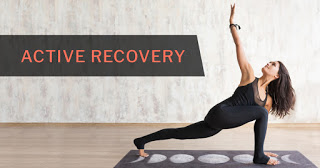Recovery is essential when it comes to exercise, but recovery doesn’t always entail total inactivity. There are days when passive rest is what your body needs, but other times, taking a more active approach is the best way to boost recovery from exercise.
What is Active Recovery?
Active recovery involves non-strenuous aerobic activity (i.e. walking, swimming, yoga, etc). It’s typically performed on a day after a high-intensity workout.
Importance
Not only is it beneficial for overall physical performance, but it can also be a chance for you to take a mental break from your regular training. Active recovery can provide the opportunity for those who train at maximum effort or perform high-intensity workouts to reduce their training intensity and focus on technique. Active recovery days should aim to:
- Address common problematic areas, such as poor mobility or weak glutes and core
- Elevate your heart rate and help you break a sweat – without the additional join stress that comes with traditional cardio and HIIT workouts
- Promote additional blood flow to sore and stiff muscles
- Prepare your body for its next training day without causing fatigue
Benefits
When you train hard, you lose fluid, damage muscle tissue, and deplete energy stores in your body. If you don’t allow enough time for your body to repair itself, this can lead to over-training and heightened stress. Benefits of active recovery include:
- Reducing fatigue and build up of toxins, like lactate, in the muscles
- Replenishing energy stores and fluids in the body
- Increasing blood flow to the muscles
- Repairing damaged muscle tissues
- Stretching sore muscles to keep them flexible
- Helping maintain your fitness progress and routine
Examples/Ideas
1. Steady-State or Non-Impact Cardio
This can be a low-intensity session on a treadmill, rower, or bike with the aim to keep your heart rate between 120-140 bpm. Low-intensity, steady-state (LISS) cardio is great for both muscle recovery and for promoting fat use for fuel through utilizing our aerobic energy systems.
2. Yoga
Yoga lengthens our muscles and tendons, aids in their recovery, and helps our body develop better mobility and flexibility.
3. Light-Resistance Training
You can use light weights or body weight movements incorporated into a low-moderate circuit.
4. Mobility, Hip, and Core Activation
Dynamic stretching and mobility work helps prepare our body for the stressors of strength training and assists in injury prevention and flexibility.
5. Self-Myofascial Release
Foam rolling and trigger point therapies are ideal to massage inflamed and overtaxed muscles helping to alleviate muscle soreness by increasing blood flow to the area.
-Paulina Le
Health Fitness Specialist
